Right Royal Progress for Premiership new boys Reading
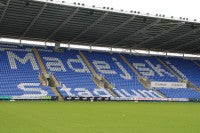 After one of the most exciting finishes to a Premier League campaign, it is no wonder it is considered to be one of the most prized and richest leagues in world football and, for those fortunate enough to compete in it, the financial rewards are estimated at around £85m annually.
After one of the most exciting finishes to a Premier League campaign, it is no wonder it is considered to be one of the most prized and richest leagues in world football and, for those fortunate enough to compete in it, the financial rewards are estimated at around £85m annually.
Every season, after thirty-eight fiercely contested matches for each team, there are winners and losers. This year's losers - Wolverhampton Wanderers, Blackburn and Bolton - have been relegated to the Championship. Taking their place at the top table for 2012/13 will be Reading, Southampton and West Ham; all three have previously been Premiership sides, and all have a stadium and a fan base deserving of the elite.
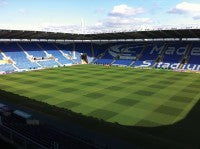 Reading's Madejski Stadium was opened in August 1998 at a total cost of more than £50m. The high-class Royal Berkshire Conference Centre and the Millennium Madejski Hotel, as well as the £1m Indoor Training Centre, all add up to an impressive facility and, with a highly ambitious multi-millionaire Chairman, John Madejski, at the helm, the club are certainly 'fit for purpose' in the Premier League.
Reading's Madejski Stadium was opened in August 1998 at a total cost of more than £50m. The high-class Royal Berkshire Conference Centre and the Millennium Madejski Hotel, as well as the £1m Indoor Training Centre, all add up to an impressive facility and, with a highly ambitious multi-millionaire Chairman, John Madejski, at the helm, the club are certainly 'fit for purpose' in the Premier League.
On the pitch, it didn't start quite as planned, and the club spent their first two seasons at the Madejski Stadium in Division Two. But, since 2000, the Royals have enjoyed a dramatic upturn in fortunes - gaining promotion to Division One in 2002 and reaching the Premiership for the first time in 2006.
The magnificent playing arena has won high praise from sports fans all around the world, including being named Europe's Best Mid-Sized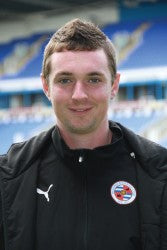 Arena by American TV Sports Channel, ESPN.
Arena by American TV Sports Channel, ESPN.
The stadium staged its first international in September 1999, when England's under 21 side gave minnows Luxembourg a 5-0 thumping in front of a crowd approaching 20,000. Since then, Reading has played host to further under 21 internationals as well as a memorable under 20 fixture against Germany in February, when local boy Nathan Tyson capped a fine debut with two stunning strikes to give England victory.
Rugby League World Cup action has also taken place at the Madejski, with New Zealand thrashing the Cook Islands in the autumn of 2000, whilst rugby union is regularly on the menu, with top English Premiership side, London Irish, playing all their home games here.
Taking into account all league and cup fixtures for both football and rugby, along with a number of practice matches, end of season finals and corporate games, the pitch has, this year had in excess of fifty games played on it.
Greg Bolton is the new Head Groundsman at the Madejski Stadium, having taken over, last September, from Bruce Elliot who, after seven years at the helm, moved to take on the role of Head Groundsman at Craven Cottage. Typical of the club, Greg was promoted from within - it was a similar promotion that saw their successful 'caretaker' manager, Brian McDermott, eventually take over the reins from Brendan Rogers.
Greg, at the age of twenty-six, is now one of the youngest Premiership Head Groundsmen. He joined the club ten years ago, after enrolling on a fine turf course at the Berkshire College of Agriculture.
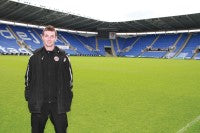 The club employ six groundstaff. Greg and Steve Davies work permanently at the main stadium, whilst the other four - Adam Grantham, Scott O'nyons, Dominic Murray and James Stabler - work at the training ground under the day-to-day supervision of Adam. James is called upon to help out at the stadium pitch as and when required.
The club employ six groundstaff. Greg and Steve Davies work permanently at the main stadium, whilst the other four - Adam Grantham, Scott O'nyons, Dominic Murray and James Stabler - work at the training ground under the day-to-day supervision of Adam. James is called upon to help out at the stadium pitch as and when required.
The club invested in a Desso pitch in 2000, and Greg says that the management have always supported the needs of the groundstaff in terms of providing them with the relevant equipment to do their job. Most recently, two SGL MU360 lighting rigs have been purchased to help promote grass growth.
Greg is still coming to terms with being the Head Groundsman and knowing that the condition of the pitch is purely down to the decisions he now makes. "Not much has changed in terms of general maintenance regimes undertaken since Bruce left," says Greg. "He was a willing mentor."
"Mowing regimes are tailored around a height of cut between 27-30mm, using a combination of rotary mowers and the Dennis G760 cylinder cassette mowers. Frequency is dependent on growth and fixtures."
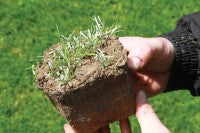 "Feeding regimes are designed to keep the sward in the best of health, promoting good colour and good root growth, to be better able to withstand pest and disease attacks. Combinations of granular and liquid feeds are applied on a fortnightly cycle throughout the year," explains Greg. "These are all based around a programme set out by Headland Amenity, using a range of multi green, seaweed, turf tonics, bio-stimulants and turf iron products."
"Feeding regimes are designed to keep the sward in the best of health, promoting good colour and good root growth, to be better able to withstand pest and disease attacks. Combinations of granular and liquid feeds are applied on a fortnightly cycle throughout the year," explains Greg. "These are all based around a programme set out by Headland Amenity, using a range of multi green, seaweed, turf tonics, bio-stimulants and turf iron products."
"Some other organic products are being used, in the form of amino acids, biomass sugars and stimulants as and when required."
"We've had a nematode problem for a number of years," bemoans Greg. "We take regular soil samples to count nematode populations, with the aim of keeping numbers at a manageable level. We are currently controlling them with a product called Nemaclear, applying it when the nematodes are active, and particularly during their juvenile J2 stage. The product was developed by Dean Gilasbey at the Swansea Scarlets stadium, and we are seeing encouraging results. Time will tell."
"I was also interested to see the Leicester City physio taking Clegg Hammer readings when they played here. He is studying pitch hardness at all away games, as well as their home games, for a university paper on pitch hardness. It certainly shows the difference in hardness on different areas of the pitch. As you might expect, the goalmouths and centre circles are the hardest, whilst the wings are softer."
"He suggests that pitches should be between 80-99 gravities. Anything above that and players could become more susceptible to injuries. It is something I may well consider doing myself having seen his results."
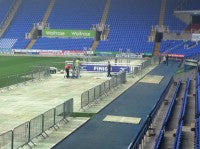 "Overall though, I've been pleased with how the pitch has performed this year. Having the SGL lighting rigs has certainly been a great help. We also have a couple of small rigs for localised areas. At the moment, the large rigs are used on the most shaded parts of the pitch. Having only two dictates how they can be used, as it takes four days to treat one half of the pitch. We move them every twenty-four hours."
"Overall though, I've been pleased with how the pitch has performed this year. Having the SGL lighting rigs has certainly been a great help. We also have a couple of small rigs for localised areas. At the moment, the large rigs are used on the most shaded parts of the pitch. Having only two dictates how they can be used, as it takes four days to treat one half of the pitch. We move them every twenty-four hours."
"Getting the best out of the rigs is down to how quickly we can get them on and off the pitch between fixtures and maintenance operations," explains Greg. "It physically takes a couple of hours to set the rigs up. So, with only two staff working at the stadium, it often becomes a challenge to fit them in with all the fixtures and the work required on the pitch."
"They certainly came in handy back in March, when the stadium was used as the finish to the Reading half marathon. This required having the perimeter of the pitch covered, and the grass lost a bit of colour. The lights helped to promote much needed growth."
Greg aerates the pitch on a monthly basis using a Toro Pro-core 648 pedestrian aerator. "I never aerate too close to matches, though" says Greg.
 "Having to cater for dual sports can be pretty demanding, but we have been doing it for so long now that we just take it in our stride. It's only when we have back to back games or, worst still, three fixtures within a week, that the job can be a bit stressful."
"Having to cater for dual sports can be pretty demanding, but we have been doing it for so long now that we just take it in our stride. It's only when we have back to back games or, worst still, three fixtures within a week, that the job can be a bit stressful."
"One thing I have changed since taking over from Bruce, is the amount of water we put on the pitch. In the past, we used to water quite heavily, two to three days before a match. Now, we will only water to replace that lost by evaportranspiration. Of course, we continue to water an hour before kick off to provide some surface pace."
The most problems tend to come from having both sports on the same weekend, as any damage caused by the football on a Saturday doesn't get a chance to recover before the rugby on Sunday.
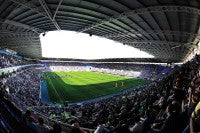 "For example, last October we played Derby on a Tuesday evening, Southampton the following Saturday and London Irish had a home game on the Sunday. It was a long working week, fitting in all the preparation and repairs in between the matches. But, we've got the changeover's down to a fine art."
"For example, last October we played Derby on a Tuesday evening, Southampton the following Saturday and London Irish had a home game on the Sunday. It was a long working week, fitting in all the preparation and repairs in between the matches. But, we've got the changeover's down to a fine art."
"As soon as a football match has finished, we remove the goalposts, clean the pitch up, green out the lines, mow, mark out for rugby and put up the rugby posts. We us very light, telescopic ones that are easy to handle. Two post sockets are set on the six yard line, and it's simply a case of removing the turf plug and socket cap and placing the posts into the sockets. Both sets of posts can be put up within an hour. Both white and green line marking is done using a transfer wheel line marker."
End of season renovations took place in early June , when contractors Hewitts arrived on site to clean out the surface debris to expose 20 mm of the Desso Fibres which had become embedded in the surface.
The next task was to pull a meadow rake through the surface in numerous directions to remove any remaining vegetation/organic layer, and to stand up the Desso fibres. This was closely followed by a tractor mounted sweeper to remove any loose debris.
 "The pitch was then verti-drained to relieve any compaction, and topdressed with 80 tonnes of new rootzone, along with some mustard bran to suppress the nematodes. It was then oversown with twenty bags of Johnsons Premier Pitch seed in three passes, assisted by a pre-seeding fertiliser."
"The pitch was then verti-drained to relieve any compaction, and topdressed with 80 tonnes of new rootzone, along with some mustard bran to suppress the nematodes. It was then oversown with twenty bags of Johnsons Premier Pitch seed in three passes, assisted by a pre-seeding fertiliser."
"Germination sheets will be laid over the whole pitch and left on for several days until the seed has germinated. The first cut will be carried out with our Honda rotaries followed, after a couple of weeks, with the cylinder mowers," explains Greg.
"The club are hosting an Olympic Torch Event on the 10th July which will require the pitch to be covered for four days with Supatrack to protect it. We'll put on some PrimoMaxx and additional growth promoters to help protect the grass and aid rapid recovery after the event. We need to be ready for our first friendly on 11th August."
"I'm really looking forward to being back in the Premiership with all that entails. It has been six years since we were last in the top flight. I appreciate that our pitch will come under much closer scrutiny next season as we will, no doubt, be involved in many more televised games. But, I'm confident that I can provide a playing surface worthy of the best football league in the world."
